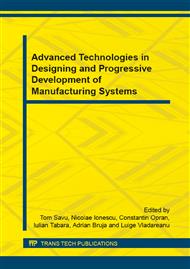[1]
T. Susuzlu, A. Hoogstrate, Initial research on the ultra-high pressure water jet up to 700Mpa, Journal of Materials Processing Technology, (2007) 149(1): 30-36.
DOI: 10.1016/j.jmatprotec.2003.11.044
Google Scholar
[2]
M. Hashish. Method and apparatus for abrasive water jet milling: Patent Application US5704824, USA, (1996).
Google Scholar
[3]
M.C. Kong, D. Axinte, W. Voice: Aspects of material remouval mechanism in plain waterjet milling on gamma titanium aluminide, Journal of Materials Processing Tehnology, 135 (2010) 141–897.
DOI: 10.1016/j.jmatprotec.2009.11.009
Google Scholar
[4]
J. Wang, D.M. Guo, The cutting performance in multipass abrasive water jet machining of industrial ceramics, Journal of Material Processing Technology 133 (2003) 371–377.
DOI: 10.1016/s0924-0136(02)01125-1
Google Scholar
[5]
A. Popan. PhD thesis, Research on manufacturing using abrasive water jet milling end cutting, (2011).
Google Scholar
[6]
K. Farhad, Hamid K, Modeling and Optimization of Abrasive Water Jet Parameters using Regression Analysis, World Academy of Science, Engineering and Technology , Vol: 3 (2009) 11-23.
Google Scholar
[7]
D. Shanmugam, H. MasoodAn investigation of characteristics in abrasive water jet cutting of layered composites, Journal of materials processing technology 1(3): pp.52-59 (2007).
Google Scholar
[8]
G. Fowler, I.R. Pashby, P.H. Shipway. The effect of particle hardness and shape when abrasive water jet milling titanium alloy Ti6Al4V, Wear 266 (2009) 613–620.
DOI: 10.1016/j.wear.2008.06.013
Google Scholar
[9]
P. Borkowski,. Technique for spatial objects shaping with abrasive water jet controlled by virtual image luminance, The Archive of Mechanical Engineering VOL. LVII 10. 2478/v10180-010-0013-z (2010).
DOI: 10.2478/v10180-010-0013-z
Google Scholar
[10]
K. Ojmertz. AWJ slot milling: A preliminary test for industrial application, PhD paper 5, external report: PTE 97: 02, Chalmers University of technology, Gotenborg, Sweden, 1- 16 (1997).
Google Scholar
[11]
D.K. Shanmugbm, J. Wang, H. Liu. Minimisation ok kerf tapers in abrasive waterjet machining of alumina ceramics using a compensation technigue, , Journal of Materials Processing Technology 112 (2008) 125-557.
DOI: 10.1016/j.ijmachtools.2008.07.001
Google Scholar
[12]
G. Fowler, P.H. Shipway, I.R. Pashby, A technical note on grit embedment following abrasive water-jet milling of a titanium alloy, Journal of Materials Processing Technology 159 (2005) 356–368.
DOI: 10.1016/j.jmatprotec.2004.05.024
Google Scholar
[13]
I. Buranský, L. Morovič, Application of Reverse Engineering for redesigning and manufacturing of a printer spare part, Advanced Materials Research. - ISSN 1022-6680(P), Dalian, China (2013), 2708-2712.
DOI: 10.4028/www.scientific.net/amr.690-693.2708
Google Scholar
[14]
M. Ridzon, J. Bilik & M. Kosik, Effect of reducing on the mechanical properties of cold drawn tubes, 9th International DAAAM Baltic Conference , Industrial engineering , ISBN 978-9949-23-620-6 (2014) 55-57.
Google Scholar
[15]
N. Balc, A. Popan, Research on water jet milling strategies, Academic Journal of Manufacturing Engineering, AJME, Vol. X, Issue 1, ISSN 1583-7904, (2012) 57-62.
Google Scholar


